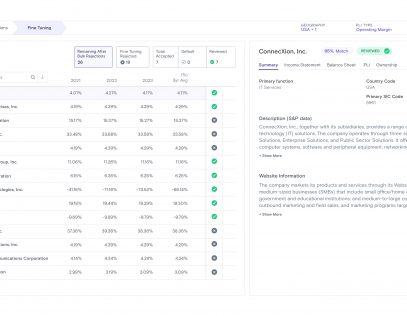What You Need to Know About Transfer Pricing Comparable Searches
Company databases used for transfer pricing comparables have not changed much in the last 60 years—unlike transfer pricing itself. This divergence should not surprise us, given the databases available were never intended solely for transfer pricing.
Aside from academic/public policy research in areas like economics, the search mechanisms are used for a multitude of business activities—domains such as mergers and acquisitions, corporate credit, and supply chain management, to name a few.
Exactera, however, has implemented a vastly different and superior comparable company search paradigm. Traditional company database search engines fail to cater to transfer pricing economic analyses for the same reason that multinationals struggle to segment their P&L statements by function for tested parties: Corporate accounting systems are intended to serve different purposes than transfer pricing economic analyses.
Segmenting a legal entity’s financial statements by its distribution and manufacturing functions requires, at the very least, allocations of expenses and often, to make assumptions, because accounting systems are set up with other priorities in mind.
Namely, things like tracking different business lines’ profitability so business leaders and managers can get the insights they need—it’s easy to see how a widget product line is doing in terms of revenue, costs/expenses, and resulting margins, and compare it to how another line of business is doing. But trying to determine the margin for distribution of products sourced from one particular affiliate is much more difficult.
How Industry Codes Really Work
Given that functional comparability drives a TNMM/CPM transfer pricing analysis, traditional search strategies in company databases performed for transfer pricing purposes would typically involve searching by some form of industry code, which is similar to the primary function of the tested party. However, these company databases generally use industry codes that are self-reported. Publicly listed companies assign their own industry codes, for example, in the U.S., noting “SIC” codes in 10-K reports.
Private companies may self-report industry codes when they file financials with local registries, such as Companies House in the United Kingdom. These registries form the source where the database companies get private company information and then redistribute it to the market. Alternatively, if a company has not self-reported its industry code in an annual report or in the local private company registry, the database company may have an analyst assign an industry code.
Searching for functionally comparable companies strictly through industry codes has two major pitfalls. The first is a false positive, meaning that your industry code search returns many companies that are not comparable to your tested party. This creates inefficiency and opportunity cost for the taxpayer attempting to prepare a transfer pricing analysis, because they spend an inordinate amount of time weeding through companies that are not comparable.
The second issue is the false negative, where you miss out on potentially good comparables because the industry code listed in the company database is not one that you used to structure your search.
This means you may be missing out on using very good comparables in your analysis, for no other reason than that they did not make it into the starting point of your search. It is also worth noting that a tax authority may use the comparables that didn’t make it into your search because they used a different search strategy, or because they knew of these comparables from prior audits.
At best, this leads to more questions from the tax authority and a drawn-out audit, and at worst, a potential adjustment based on the addition of those companies in the tax authority’s analysis.
To combat the limitations of the industry code search, a common supplemental strategy is to include various keywords in addition to the industry codes.
Unfortunately, this comes with its own set of challenges, especially when searching databases for privately held companies—which like it or not, is critical to creating comparable sets that meet tax authority requirements for local sets. (I will refrain from a debate on the reliability of public company vs private company data in transfer pricing analyses since that is its own topic altogether.)
Local private company registries primarily focus on capturing financial data, and do not capture descriptions of company operations that can be aggregated by database companies.
As a result, some market-leading database providers take the approach of using industry-code descriptions as the company description itself. For example, all companies within SIC code 7371 would receive a description of “computer programming services.” As a taxpayer, using a keyword within this vague industry code description, your search would return all companies in that SIC code anyway. So essentially, your keyword strategy is simply duplicating the results of your initial SIC code search strategy.
Better Benchmarking
A far better approach to searching company data for transfer pricing analyses is by focusing on returning companies with the same function as the tested party, regardless of the industry code or keywords within a company’s database profile.
This core transfer pricing tenet is at the core of how Exactera Compliance’s company data and search engine are structured. The user is prompted to input the function of the tested party, using major and minor functional classifications. For example, we may input a major classification of administrative and back-office services, with minor classifications of finance/accounting/legal.
Every company in the software’s records, whether it is publicly listed or privately held, is tagged with the functions it performs. This is not based on either the industry code listed for that company or the keywords in its description.
Rather, it is based on an actual qualitative review of the company’s website, which allows the functional tags to be much more precise. Through this search paradigm, the search is both much more efficient in terms of the number of companies that are returned, and much more refined, in terms of the functional compatibility of the companies that are returned.
The first step in using this superior search paradigm is to enrich the data available from the database companies specifically for transfer pricing purposes. As I mentioned earlier, especially in the case of databases that contain private company information, the qualitative information is incomplete, and the financial information is not standardized for use in transfer pricing analyses. Once the data is robust enough, the new search paradigm can be used, employing technology to automate much of the traditional trial-and-error search process.
To enrich the data, Exactera has utilized a combination of technology and human capital with an expertise to not only validate the descriptive and functional information of each company in the databases we license, but also to tag each company with the primary functions they perform.
In so doing, we are able to focus the search in the software on a very direct input—what function(s) the tested party performs—and return the relevant pool of functionally comparable companies to the user.
In other words, we have eliminated the indirect functional comparison between the tested party and companies, which SIC code searches seek to perform. Because we have the tagging mechanism built into our data, we are able to simply input the tested party’s functional characteristics, and the appropriate set of companies are returned as our starting point.
In addition to providing a refined set of comparables based on direct functional comparability, the software is also able to take advantage of quantitative filters using our database of jurisdictional regulations—since the financial data for all comparables is standardized to include and exclude items as required for transfer pricing purposes.
Given the software has the jurisdictional rules all temporally stored, it is aware of which countries require a 50% ownership filter, and which require a 25% filter, and can apply the correct one automatically to further reduce the pool of comparables—and this is only one example.
The software makes stores jurisdictional rules and applies all quantitative rejection reasons that are required for a particular country’s benchmark, and it can also make use of the tested party’s PLI to apply non-mandatory quantitative rejection reasons as well to further refine the comparables set.
Through both a qualitative screening based on functional characteristics and the automatic application of required filters, Exactera Compliance has been able to approach the concept of an automated benchmarking analysis for transfer pricing purposes.
In so doing, we are able to provide an efficient mechanism for preparing compliant transfer pricing documentation without the intimidation of traditional comparables search methodology, and we offer users who are highly experienced in transfer pricing to have input into the final set of comparables used in their transfer pricing analyses.









